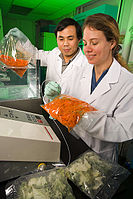
Photo from wikipedia
Abstract Compatibilized poly(lactic acid)/polypropylene (PLA/PP) blends with a drop-matrix morphology containing 25 wt.% PP, 5 wt.% ethylene/n-butyl acrylate/glycidyl methacrylate terpolymer (PTW) as compatibilizer, and 5 wt.% nanoclay were prepared by one-step mixing process… Click to show full abstract
Abstract Compatibilized poly(lactic acid)/polypropylene (PLA/PP) blends with a drop-matrix morphology containing 25 wt.% PP, 5 wt.% ethylene/n-butyl acrylate/glycidyl methacrylate terpolymer (PTW) as compatibilizer, and 5 wt.% nanoclay were prepared by one-step mixing process in a twin-screw extruder. TEM analysis revealed that the clay particles were mainly localized in the PLA matrix phase in the absence of PTW; by contrast, the addition of compatibilizer changed the location to the blend interface. Multiple rate thermogravimetric analysis revealed two-stage and single-stage weight losses under neutral and air atmospheres, respectively. To reveal the influence of blending, nanoclay inclusion and compatibilization process on the PLA degradation process, a systematic quantitative evaluation of degradation processes was carried out based on kinetic parameters derived from model-free and model-fitting analyses. The results revealed that the activation energy of the thermo-oxidative process, being significantly lower than that of the thermal pyrolysis, greatly increases in the presence of nanoclay, indicating the accelerating role of oxygen in the degradation process and the barrier effect of nanoclay against oxygen diffusion. The combined TG-DSC analysis in the nitrogen environment confirmed the appearance of endothermic signals being proportional to the sample weight loss, which is characteristic of thermal pyrolysis. Subsequently, in an oxygen-containing environment, initial exothermic peaks were formed, which was attributed to the oxidative degradation of the sample. As the reaction progressed, secondary peaks were observed due to the degradation of residuals formed in the first stage of the degradation process. Also, for chemical analysis of volatiles, simultaneous TG-FTIR analysis was employed in a neutral atmosphere at the maximum degradation temperature. Lactide, acetaldehyde, carbon dioxide (CO2) and carbon monoxide (CO) were the products obtained from the degradation process of the PLA phase.
Journal Title: Thermochimica Acta
Year Published: 2020
Link to full text (if available)
Share on Social Media: Sign Up to like & get
recommendations!